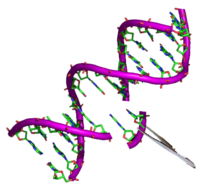
Photo from wikipedia
In vertebrates and invertebrates, the insulin/insulin-like growth factor 1 (IGF1) signaling (IIS) cascade is highly conserved and plays a vital role in many different physiological processes. Among the many tissues… Click to show full abstract
In vertebrates and invertebrates, the insulin/insulin-like growth factor 1 (IGF1) signaling (IIS) cascade is highly conserved and plays a vital role in many different physiological processes. Among the many tissues that respond to IIS in mosquitoes, the fat body has a central role in metabolism, lifespan, reproduction, and innate immunity. We previously demonstrated that fat body specific expression of active Akt, a key IIS signaling molecule, in adult Anopheles stephensi and Aedes aegypti activated the IIS cascade and extended lifespan. Additionally, we found that transgenic females produced more vitellogenin (Vg) protein than non-transgenic mosquitoes, although this did not translate into increased fecundity. These results prompted us to further examine how IIS impacts immunity, metabolism, growth and development of these transgenic mosquitoes. We observed significant changes in glycogen, trehalose, triglycerides, glucose, and protein in young (3-5 d) transgenic mosquitoes relative to non-transgenic sibling controls, while only triglycerides were significantly changed in older (18 d) transgenic mosquitoes. More importantly, we demonstrated that enhanced fat body IIS decreased both the prevalence and intensity of Plasmodium falciparum infection in transgenic An. stephensi. Additionally, challenging transgenic An. stephensi with Gram-positive and Gram-negative bacteria altered the expression of several antimicrobial peptides (AMPs) and two anti-Plasmodium genes, nitric oxide synthase (NOS) and thioester complement-like protein (TEP1), relative to non-transgenic controls. Increased IIS in the fat body of adult female An. stephensi had little to no impact on body size, growth or development of progeny from transgenic mosquitoes relative to non-transgenic controls. This study both confirms and expands our understanding of the critical roles insulin signaling plays in regulating the diverse functions of the mosquito fat body.
Journal Title: Insect biochemistry and molecular biology
Year Published: 2021
Link to full text (if available)
Share on Social Media: Sign Up to like & get
recommendations!